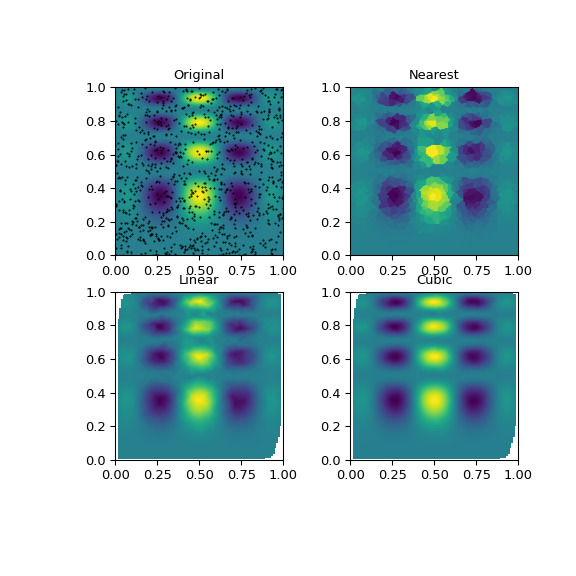本文简要介绍 python 语言中 scipy.interpolate.griddata 的用法。
用法:
scipy.interpolate.griddata(points, values, xi, method='linear', fill_value=nan, rescale=False)#插入非结构化D-D 数据。
- points: 具有形状 (n, D) 的浮点数的二维 ndarray,或具有形状 (n,) 的一维 ndarray 的长度 D 元组。
数据点坐标。
- values: 浮点数或复数的ndarray,形状(n,)
数据值。
- xi: 具有形状 (m, D) 或长度为 D 的 ndarray 元组的二维 ndarray 可广播到相同形状。
插入数据的点。
- method: {‘linear’, ‘nearest’, ‘cubic’},可选
插值方法。之一
nearest返回最接近插值点的数据点的值。有关详细信息,请参阅
NearestNDInterpolator。linear将设置为 N-D 单纯形的输入点细分,并在每个单纯形上进行线性插值。有关详细信息,请参阅
LinearNDInterpolator。cubic(一维)返回从三次样条确定的值。
cubic(二维)返回从分段三次、连续可微 (C1) 和近似 curvature-minimizing 多项式曲面确定的值。有关详细信息,请参阅
CloughTocher2DInterpolator。
- fill_value: 浮点数,可选
用于填充输入点凸包之外的请求点的值。如果未提供,则默认值为
nan。此选项对‘nearest’ 方法无效。- rescale: 布尔型,可选
在执行插值之前将点重新缩放到单位立方体。如果某些输入维度具有不可比较的单位并且相差许多数量级,这将很有用。
- ndarray
插值数组。
参数 ::
返回 ::
注意:
注意
对于常规网格上的数据,请改用
interpn。例子:
假设我们要对二维函数进行插值
>>> import numpy as np >>> def func(x, y): ... return x*(1-x)*np.cos(4*np.pi*x) * np.sin(4*np.pi*y**2)**2在 [0, 1]x[0, 1] 的网格上
>>> grid_x, grid_y = np.mgrid[0:1:100j, 0:1:200j]但我们只知道它在 1000 个数据点处的值:
>>> rng = np.random.default_rng() >>> points = rng.random((1000, 2)) >>> values = func(points[:,0], points[:,1])这可以使用
griddata来完成 - 下面我们尝试所有插值方法:>>> from scipy.interpolate import griddata >>> grid_z0 = griddata(points, values, (grid_x, grid_y), method='nearest') >>> grid_z1 = griddata(points, values, (grid_x, grid_y), method='linear') >>> grid_z2 = griddata(points, values, (grid_x, grid_y), method='cubic')可以看到,所有方法都在某种程度上重现了确切的结果,但是对于这个平滑函数,分段三次插值法给出了最好的结果:
>>> import matplotlib.pyplot as plt >>> plt.subplot(221) >>> plt.imshow(func(grid_x, grid_y).T, extent=(0,1,0,1), origin='lower') >>> plt.plot(points[:,0], points[:,1], 'k.', ms=1) >>> plt.title('Original') >>> plt.subplot(222) >>> plt.imshow(grid_z0.T, extent=(0,1,0,1), origin='lower') >>> plt.title('Nearest') >>> plt.subplot(223) >>> plt.imshow(grid_z1.T, extent=(0,1,0,1), origin='lower') >>> plt.title('Linear') >>> plt.subplot(224) >>> plt.imshow(grid_z2.T, extent=(0,1,0,1), origin='lower') >>> plt.title('Cubic') >>> plt.gcf().set_size_inches(6, 6) >>> plt.show()
相关用法
- Python SciPy interpolate.make_interp_spline用法及代码示例
- Python SciPy interpolate.krogh_interpolate用法及代码示例
- Python SciPy interpolate.InterpolatedUnivariateSpline用法及代码示例
- Python SciPy interpolate.BSpline用法及代码示例
- Python SciPy interpolate.LSQSphereBivariateSpline用法及代码示例
- Python SciPy interpolate.splder用法及代码示例
- Python SciPy interpolate.LinearNDInterpolator用法及代码示例
- Python SciPy interpolate.PPoly用法及代码示例
- Python SciPy interpolate.NdBSpline用法及代码示例
- Python SciPy interpolate.pade用法及代码示例
- Python SciPy interpolate.barycentric_interpolate用法及代码示例
- Python SciPy interpolate.RegularGridInterpolator用法及代码示例
- Python SciPy interpolate.NdPPoly用法及代码示例
- Python SciPy interpolate.interp2d用法及代码示例
- Python SciPy interpolate.approximate_taylor_polynomial用法及代码示例
- Python SciPy interpolate.RectSphereBivariateSpline用法及代码示例
- Python SciPy interpolate.sproot用法及代码示例
- Python SciPy interpolate.splantider用法及代码示例
- Python SciPy interpolate.CloughTocher2DInterpolator用法及代码示例
- Python SciPy interpolate.interp1d用法及代码示例
- Python SciPy interpolate.BPoly用法及代码示例
- Python SciPy interpolate.BarycentricInterpolator用法及代码示例
- Python SciPy interpolate.splrep用法及代码示例
- Python SciPy interpolate.make_smoothing_spline用法及代码示例
- Python SciPy interpolate.Rbf用法及代码示例
注:本文由纯净天空筛选整理自scipy.org大神的英文原创作品 scipy.interpolate.griddata。非经特殊声明,原始代码版权归原作者所有,本译文未经允许或授权,请勿转载或复制。
